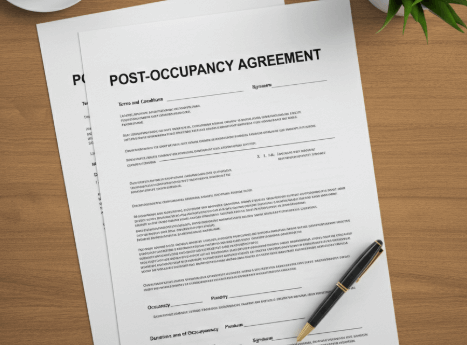In Florida’s vibrant and diverse state, homeowners and buyers increasingly encounter the term “Post-Occupancy Agreement in Florida.” This unique arrangement provides a flexible solution for both sellers and buyers, permitting the seller to stay in the residence for a set duration post-closing. Whether you’re navigating the bustling real estate markets of Miami, Tampa, or Orlando, understanding the nuances and benefits of a Post-Occupancy Agreement in Florida can be vital for a smooth and successful transaction.
Real estate investors Steve Daria and Joleigh have successfully utilized the Post-Occupancy Agreement strategy to facilitate smoother transitions in their Florida properties. This approach allows sellers to “staycation” in their homes longer while giving buyers time to prepare for their move. Steve and Joleigh’s experience underscores the agreement’s flexibility and practicality in the competitive Florida real estate market.
Understanding Post-Occupancy Agreement in Florida: A Primer
A post-occupancy agreement, often called a lease-back or rent-back agreement, allows the seller to temporarily lease the property back from the buyer after the deal.
This arrangement provides a transitional period during which the seller can continue to reside in the property while finalizing their move to a new home.
A post-occupancy agreement in Florida operates under state laws and regulations to guarantee fairness and standardization.

Key Questions to Address in a Post-Occupancy Agreement in Florida
A post-occupancy agreement (POA) in Florida’s real estate transactions must address several key questions to ensure clarity, fairness, and legal compliance.
Here are the essential questions that should be addressed:
How long will the seller lease back the property?
- Define the Lease Term: Specify the duration of the lease-back period in the agreement, including the start and end dates.
- Flexibility: Allow for some flexibility in the duration to accommodate potential delays or unforeseen circumstances while ensuring it remains within reasonable limits.
- Maximum Lease Period: Establish a maximum lease period to prevent indefinite occupancy and clarify the duration of the seller’s occupancy rights.
Who is responsible for maintenance, utilities, and insurance during the lease-back period?
- Maintenance Responsibilities: Outline the responsibilities for property maintenance during the lease-back period, including routine upkeep, repairs, and landscaping.
- Utility Payments: Specify which party is responsible for paying utilities such as electricity, water, gas, and internet services during the occupancy period.
- Insurance Coverage: Clarify insurance coverage for the property during the lease-back period, including liability insurance and property insurance, and determine who is responsible for maintaining coverage.
What happens if the seller exceeds the agreed-upon occupancy period?
- Penalties for Overstaying: Define penalties or consequences for the seller if they exceed the agreed-upon occupancy period, such as daily rental fees or legal action to enforce eviction.
- Notice Period: Establish a notice period for the seller to vacate the property after the lease-back period expires, providing sufficient time for transition and avoiding sudden eviction.
- Dispute Resolution: Include provisions for dispute resolution mechanisms in case of disagreements or disputes related to the occupancy period, such as mediation or arbitration.
Get An Offer Today, Sell In A Matter Of Days
The Seller’s Strategy: Leveraging POAs to Your Advantage
For sellers, a Post Occupancy Agreement in Florida can serve as a valuable asset for effectively managing the transition between selling their current home and moving into a new one.
Timing is Everything
- Determine move-out and move-in dates early to allow for flexibility.
- Negotiate a lease-back period that provides ample time without inconveniencing the buyer.
Operationalize the Agreement
- Clearly define utilities, insurance, and maintenance responsibilities during the lease-back period.
- Avoid ambiguity by discussing and documenting operational details upfront.
The Buyer’s Perspective: Mitigating Risk While Being Flexible
Buyers can use POAs as a risk management tool while ensuring a smooth transition post-closing.
Financial and Insurance Considerations
- Understand potential financial implications, including mortgage commitments and insurance coverage.
- Consult financial advisors and insurance providers to address any concerns.
Inspection and Damages
- Insist on an inspection either before move-out or shortly after to assess the property’s condition.
- Clearly outline damages and remediation processes in the agreement to protect your investment.

Crafting a Compelling Post-Occupancy Agreement
Customization and clarity are essential when drafting a POA to ensure a fair and practical agreement.
Tips for Comprehensive Agreements:
- Use unambiguous language throughout the document to avoid disputes.
- Seek legal counsel to review and refine the agreement, incorporating mediation clauses.
- Foster mutual understanding and goodwill between parties to facilitate a smooth transition.
Implementing Post-Occupancy Agreements Effectively
Executing a post-occupancy agreement in Florida requires proactive management and adherence to stipulations for a successful transition.
Best Practices for Maintaining Open Communication
Open communication is the cornerstone of a successful post-occupancy agreement (POA) in Florida’s real estate transactions.
Here’s how to ensure effective communication:
- Establish Clear Channels: Set up clear communication channels from the outset, including preferred methods of contact and designated points of contact for both parties.
- Regular Updates: Provide updates on any changes or developments related to the POA, including timelines, responsibilities, and potential issues.
- Transparency: Be transparent about any challenges or concerns arising during the post-occupancy period, fostering trust and cooperation between all parties.
- Accessibility: Ensure accessibility by promptly responding to emails, calls, or messages and demonstrating a commitment to promptly addressing any queries or issues.
- Scheduled Check-Ins: Schedule periodic check-ins to review progress, address emerging issues, and ensure that both parties are aligned and satisfied with the agreement’s terms.
Best Practices for Documenting Communications and Agreements
Documenting all communications and agreements related to the POA is essential for reference and dispute resolution.
Here’s how to effectively document the process:
- Create a Paper Trail: Keep a comprehensive record of all communications, including emails, written correspondence, and meeting minutes, detailing discussions, decisions, and agreements.
- Use Written Agreements: Formalize agreements in writing, outlining terms, responsibilities, and expectations clearly to minimize misunderstandings or disputes.
- Maintain Organized Records: Keep all documents and records in order and easily accessible for quick reference and retrieval.
- Confirmations and Acknowledgments: Request confirmations or acknowledgments for essential communications or agreements to ensure mutual understanding and agreement.
- Backup and Secure Documentation: Securely store documentation digitally or in hard copy and maintain backup copies to safeguard against loss or damage.
Best Practices for Approaching the Post-Occupancy Period
Approaching the post-occupancy period with professionalism and flexibility is crucial for navigating any unforeseen circumstances gracefully.
Here’s how to handle the post-occupancy period effectively:
- Professionalism: Maintain a professional demeanor throughout the post-occupancy period, adhering to the agreement’s terms and attending to any issues or concerns promptly and courteously.
- Flexibility: Remain flexible and adaptable in responding to unexpected changes or challenges, demonstrating a willingness to collaborate and find mutually beneficial solutions.
- Problem-Solving Orientation: Adopt a problem-solving orientation, focusing on finding practical solutions to any emerging issues or conflicts rather than placing blame or engaging in adversarial interactions.
- Timely Resolution: Prioritize timely resolution of any disputes or disagreements arising during the post-occupancy period, seeking amicable resolutions through negotiation or mediation where necessary.
- Continuous Communication: Keep open lines of communication with all parties involved, providing regular updates on progress and addressing any concerns promptly to ensure a smooth and successful transition.
Conclusion
Mastering post-occupancy agreements in Florida’s real estate market is a strategic move for sellers and buyers. By understanding the nuances of a Post-occupancy agreement in Florida and implementing them effectively, you can streamline property transactions and ensure a smooth transition between ownerships.
Whether you’re leveraging a POA to ease your transition or mitigating risks as a buyer, strategic utilization of this contractual tool can lead to positive outcomes in Florida’s vibrant real estate landscape.
**NOTICE: Please note that the content presented in this post is intended solely for informational and educational purposes. It should not be construed as legal or financial advice or relied upon as a replacement for consultation with a qualified attorney or CPA. For specific guidance on legal or financial matters, readers are encouraged to seek professional assistance from an attorney, CPA, or other appropriate professional regarding the subject matter.

